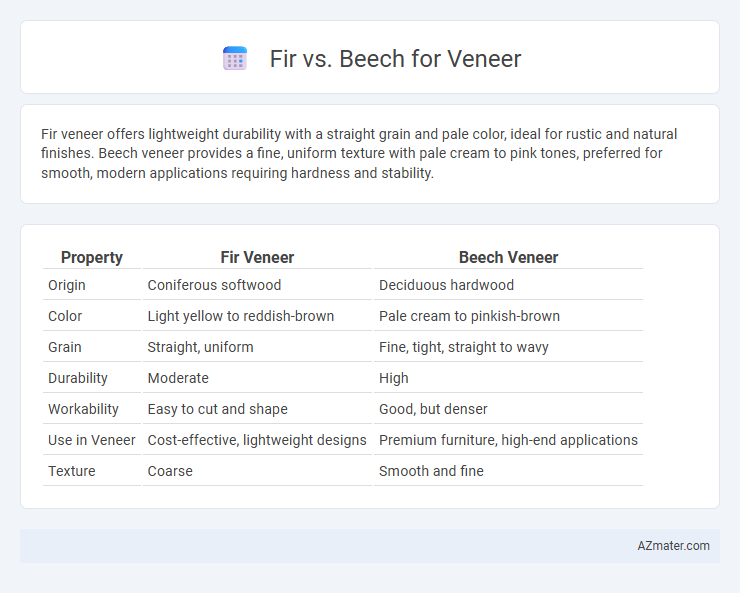Fir veneer offers lightweight durability with a straight grain and pale color, ideal for rustic and natural finishes. Beech veneer provides a fine, uniform texture with pale cream to pink tones, preferred for smooth, modern applications requiring hardness and stability.
Table of Comparison
| Property | Fir Veneer | Beech Veneer |
|---|---|---|
| Origin | Coniferous softwood | Deciduous hardwood |
| Color | Light yellow to reddish-brown | Pale cream to pinkish-brown |
| Grain | Straight, uniform | Fine, tight, straight to wavy |
| Durability | Moderate | High |
| Workability | Easy to cut and shape | Good, but denser |
| Use in Veneer | Cost-effective, lightweight designs | Premium furniture, high-end applications |
| Texture | Coarse | Smooth and fine |
Introduction to Fir and Beech Veneer
Fir veneer offers a light, warm tone with a straight, fine grain pattern, making it ideal for modern and minimalist furniture. Beech veneer is known for its smooth texture and pale cream color, providing a consistent and uniform appearance suitable for traditional and contemporary designs. Both veneers are prized for their workability and durability in cabinetry, paneling, and decorative surfaces.
Botanical Overview: Fir vs Beech
Fir (Abies spp.) and Beech (Fagus spp.) exhibit distinct botanical characteristics influencing their use in veneer production. Fir is a softwood from coniferous trees and features a light color with uniform texture, facilitating smooth finishing and strength in veneers. Beech, a hardwood from deciduous trees, presents tight grain patterns and a pale cream to pinkish-brown hue, offering high hardness and durability ideal for decorative and resilient veneer surfaces.
Appearance and Grain Patterns
Fir veneer exhibits straight, pronounced grain patterns with a warm, reddish-brown hue that enhances rustic and traditional design aesthetics. Beech veneer features a fine, uniform grain with a pale, creamy color, offering a smooth and consistent surface ideal for modern and minimalist interiors. The distinct grain variations in fir provide a more textured visual appeal, while beech's subtle grain creates an elegant, refined look.
Durability and Strength Comparison
Fir veneer offers moderate durability with good resistance to wear, making it suitable for interior applications where strength is essential but heavy loads are uncommon. Beech veneer exhibits higher strength and greater hardness, providing superior durability for furniture and surfaces subject to frequent impact or heavy use. Both woods have distinctive grain patterns, but Beech's dense cellular structure enhances its resistance to dents and scratches compared to the softer Fir.
Workability and Machining Differences
Fir veneer offers excellent workability due to its straight grain and softer texture, making it easier to cut, shape, and sand compared to beech. Beech veneer, with its harder and denser wood structure, provides smoother finishes but requires sharper tools and slower machining to avoid burn marks and splintering. Differences in hardness and grain complexity mean fir is preferred for projects needing rapid fabrication, while beech suits fine detail work demanding higher precision.
Cost and Availability
Fir veneer generally offers a lower cost compared to beech veneer due to its widespread availability and faster growth rate across North America and Europe. Beech veneer, valued for its fine grain and durability, tends to be more expensive and less readily available, as it grows more slowly and is harvested in more limited regions primarily in Europe. Cost efficiency and abundant supply make fir veneer ideal for budget-sensitive projects, while beech veneer suits applications demanding higher aesthetic quality and structural strength.
Environmental Impact and Sustainability
Fir veneer, sourced from fast-growing coniferous trees, offers a renewable option with lower carbon footprint due to quicker regrowth cycles compared to beech, which is derived from slower-growing hardwood species. Beech veneer, while denser and more durable, typically demands longer forest maturation times and careful forest management to maintain biodiversity and prevent deforestation. Sustainable sourcing certifications such as FSC or PEFC are critical to ensuring both fir and beech veneers support responsible forestry practices and minimize environmental impact.
Common Applications in Veneer
Fir veneer is commonly used in construction and furniture making due to its strength and cost-effectiveness, often applied in cabinetry, paneling, and plywood. Beech veneer, valued for its fine grain and uniform texture, is preferred in high-end furniture, flooring, and decorative paneling where aesthetic appeal is critical. Both veneers contribute to structural integrity, but beech excels in applications requiring a smooth, refined finish.
Maintenance and Longevity
Fir veneer offers moderate maintenance with natural resistance to decay, making it suitable for indoor applications where durability is important but heavy wear is limited. Beech veneer provides superior longevity due to its dense grain structure and hardness, requiring less frequent refinishing and better resistance to dents and scratches. Routine cleaning and occasional sealing are recommended for both, but Beech's tougher composition generally leads to lower long-term upkeep costs and extended lifespan compared to Fir.
Choosing the Right Wood for Your Project
Fir veneer offers a straight grain and consistent texture, making it ideal for modern, minimalist designs requiring durability and ease of finishing. Beech veneer features a fine, tight grain with a uniform color, providing a smooth surface perfect for detailed craftsmanship and elegant furniture pieces. Selecting Fir ensures strength and cost-efficiency, while Beech delivers aesthetic refinement and versatility for high-end projects.

Infographic: Fir vs Beech for Veneer
 azmater.com
azmater.com